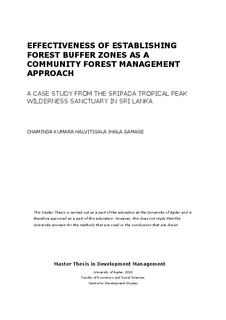| dc.description.abstract | The Sripada Tropical Peak Wilderness Sanctuary (STPWS) in Sri Lanka which is located
between latitudes 6˚- 45 ́- 6˚- 57 ́ N and longitudes 80˚- 27́-80˚-50 ́ E comes under the
category of ‘Wet Ever Green Tropical Rain Forests’ and spreads over 224 square kilometers
around the Sripada mountain range. In the peripheral areas of the forest sanctuary, there are a
considerable number of villages and the forest has been utilized over centuries by the
villagers on various purposes. Since over utilization of forest resources may easily induce
forest degradation, the gradual swell of population in the forest periphery has threatened the
survival of the forest. Given that aspect, the Forest Department of Sri Lanka has decided to
establish Forest Buffer Zones (FBZs) in the periphery of the STPWS in 1972-73 with the aim
of conserving of the dense forest via attempting to satisfy the communal needs for forest
resources with the resources available within the FBZs themselves. Accordingly, while the
main objective of the present research has been to analyze the effectiveness of establishing
FBZs in the STPWS as an approach to Community Forest Management, the central research
problem is to scrutinize whether both socioeconomic development of the rural community
and conservation of the forest sanctuary can jointly be achieved through the establishment of
FBZs. As the study area of the research, the STPWS, Sripalabaddala and Guruluwana GN
divisions to the Southwest of the forest, as well as two FBZs, viz. #1 and #2, situated between
the forest sanctuary and Guruluwana have been selected. Whereas there are no FBZs in
between Sripalabaddala and the forest sanctuary, Sripalabaddala has been selected with the
purpose of conducting a comparative study therewith. As regards sources and types of the
data, both qualitative and quantitative data as well as primary and secondary data were
collected. In order to collect primary data, questionnaire survey, case studies, quadrate
analysis, observation, and discussion methods were employed. One of the key findings of the
research was that forest resource utilization holds economical as well as social value to
communities residing in the peripheral areas of the forest sanctuary. The villagers from
Sripalabaddala have indifferently been utilizing the STPWS to gather forest produce due to
the absence of any FBZ. However, the villagers from Guruluwana have utilized both the
forest sanctuary and the FBZ #1 for the aforesaid purpose except the FBZ #2 which has been
left behind owing to the scarcity of required forest resources therein. The FBZ #1 has been
established by using Albezia (Albezia molucana), which grows in harmony with other local
endemic plant species and fauna. Yet, the FBZ #2 established with Araucaria (Araucaria
cookie) specie has hindered the growth of other local endemic species. When gathering of
non-Timber Forest Produce, gem mining and poaching are entertained, the forest resource
users have successfully been directed to the FBZ #1 from the STPWS. However, the forest
sanctuary is continually being utilized by the villagers for timber extraction, gathering of
costly resin varieties and spices since those are rarely available in the FBZ #1. In general, the
FBZ #1 has considerably contributed to satisfy the needs of the community for forest
produce. Underscored is that, when community involvement in the project is reflected on, the
community participation in planning, monitoring, and evaluation phases is rather poor and
consequently it has resulted in a number of project failures. The research concludes that the
concept of establishing FBZs remains effective in both fulfilling the needs of the community
that reside in the peripheral areas of the forest for forest produce and conserving the dense
forest. Yet, realistically, the community involvement in every phase of such a project should
be prioritized, regularly monitored and, prior to planning the project, every sphere of the
patterns and needs of forest resource utilization by the community should thoroughly be
examined. Moreover, the use of local, endemic, and commonly utilized plant species by
community members in the establishment of FBZs would significantly increase the
effectiveness of the project. | en_US |
